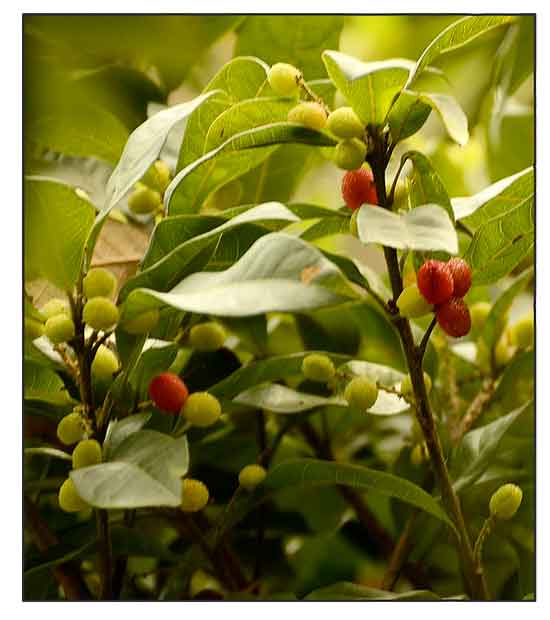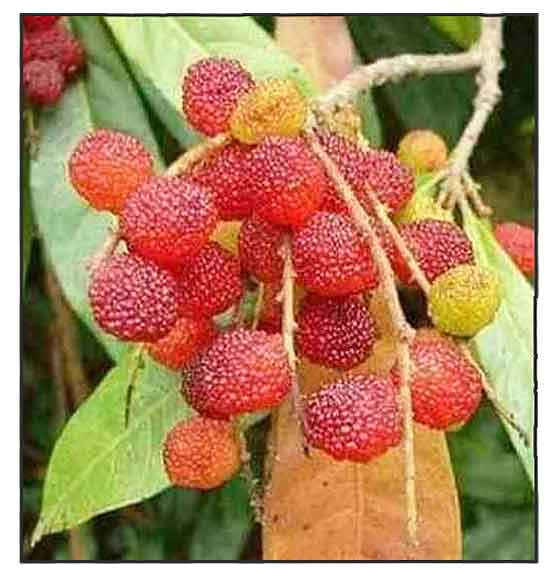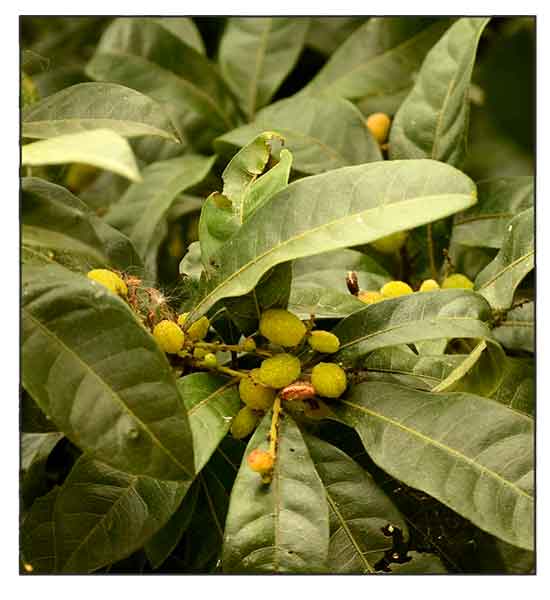 Gen info Gen info
- The genus Myrica consists of about 97 species of small tree and aromatic shrubs in the family Myricacea, globally distributed in both temperate and sub-tropical regions.
- Myrica esculenta is the state fruit of the northern Indian state of Uttarakhand.
(2)
- It has four known varieties. (see infraspecifics, above)
- According to Ayurveda, it has two varieties based on flower color: Shweta (white) and Rakta (red). (2)
Botany
• Myrica esculenta is a medium to large woody tree about 12-15 m in height with trunk diameter about 92.5 cm. Bark: Outer bark is grayish dark in color, rough, vertically wrinkled while inner bark is dark brown in color with smooth surface; fracture hard; bitter in taste and nauseating odor. Leaves: Leaves are lanceolate with entire or serrate margin, having pale green at lower surface and dark green at upper surface, about 9-12 cm in length and 3-3.5 cm in width and are mostly crowded toward the ends of branches. Flowers: Pistillate flowers are small, sessile, solitary and bracteates; sepals and petals are either absent or not visible; inflorescence (catkin), 4.2 cm long, axillary, bearing about 25 flowers in a thread-like style while inflorescence of staminate flowers is compound raceme. Fruit: Tree yields a drupe fruit, red to dark brown in color, ellipsoidal or oval in shape and about 2-7 mm in diameter having sweet and sour taste containing ovoid shaped, smooth surface light brown colored seed of about 1-6 mm in diameter with oily taste. (5)
Distribution
- Native to the Philippines.
- Also native to
Assam, Bangladesh, Borneo, China, East Himalaya, Jawa, Lesser Sunda Is., Malaya, Myanmar, Nepal, Sumatera, Thailand, Vietnam. (1)
 Constituents Constituents
- Study of stem bark yielded total phenolics of 276.78 mg GAE/g d.w., and total flavonoids of 121.68 QE/g d.w. (3)
- Mineral analysis of fruit and stem bark (mg/g) yielded calcium (4.63 and 3.155), potassium ( 7.75 and 2.939), magnesium (8.4 and 1.061), sodium (0.81 and 0.060), phosphorus (0.24 and 0.030), manganese (0.032 and NR), iron 0(.404 and 0.123), zinc (0.216 and 0.0060, copper 0.004 and NR), sulphur (NR and 0.277). (3)
- Bioactive compounds isolated from various parts include: (1) Gallic acid, (2) Epigallocatechin 3-O-gallate, (3) i) Epigallocatechin-(4β→8)-epigallocatechin-3-O-gallate, ii) 3-O-galloyl-epigallocatechin-(4β→8)-epigallocatechin-3-O-gallate, (4) Castalagin, (5) Catechin, (6) Chlorogenic acid, (7) p-coumaric acid, (8) Ethyl-β-D-glucopyranoside, (9) 3-hydroxybenzaldehyde, (10) Isovanillin, (11) Ferulic acid, (12) Myricetin, (13) i) Flavone 4′-hydroxy-3′,5,5′-trimethoxy-7-O-β-D-glucopyranosyl(1→4)-α-L-rhamnopyranoside, ii) flavone 3′,4′-dihydroxy-6-methoxy-7-O-α-L-rhamnopyranoside, (14) Myricitrin, (15) Lupeol, (16) Oleanolic acid, (17) Trihydroxytaraxaranoic acid, (18) Dihydroxytaraxerane, (19) Dihydroxytaraxaranoic acid, (20) Tetrahydroxytaraxenoic acid, (21) 3-epi-ursonic acid, (22) Prodelphinidin dimer, (23) Myricanol, (24) Myricanone.
(3)
 - Preliminary phytochemical screening of various extracts of leaves yielded alkaloids, flavonoids, saponins, proteins and amino acids, fixed oils and fats, glycosides, tannins, and steroids. (4) - Preliminary phytochemical screening of various extracts of leaves yielded alkaloids, flavonoids, saponins, proteins and amino acids, fixed oils and fats, glycosides, tannins, and steroids. (4)
- Study of crude extracts of fruits yielded total phenolic content (1.78 to 2.51 mg GAE/g fw and total flavonoids (1.31 to 1.59 mg QE/g fw). (see study below) (6)
- Phytochemical screening of leaf extracts yielded alkaloids, flavonoids, carbohydrates, tannins, vitamin C, fats and oils, terpenoids, and phenols. Total phenolic and flavonoid contents were 97.66 mg GA/g and 51.3 mg RE/g of leaf extract, respectively. (see study below) (7)
- GC-MS analysis of fresh fruit extract revealed presence of 4H-pyran-4-one, pentadecanoic acid, 2-furancarboxaldehyde, phytol and hexadecanoic acid. (see study below) (8)
- Nutritional analysis of fruit yielded (%) ash 2.18, moisture 7y2.33, crude fat 4.93, crude fiber 5.22, crude protein 9.62, carbohydrate 78.03; energy 395 Kcal/g. Minerals analysis (mg/g) yielded calcium 4.63, magnesium 8.4, potassium 7.75, phosphorus 0.24, sodium 0.81, manganese 0.032, zinc 0.216, iron 0.404, and copper 0.004. (5)
- Phytochemical screening of 70% ethanol extract of stem bark yielded carbohydrates, saponins, flavonoids, phenolics, glycosides, proteins, volatile oils, tannins, and mucilage, with absence of alkaloids, fat and fatty acids, phytosterols, and flavone glycosides. (see study below) (12)
- Study of ME of fruit isolated four major anthocyanins viz., Malvidin 3-(6''-acetylglucoside), Cyanidin-3-O-(6''-acetylglucoside), Delphinidin-3-O-arabinoside and Cyanidin-3.5-di-O-beta-D-glucoside. The total monomeric anthocyanin content (TMAC) was found to be 1.58 ± 0.4 mg/100 g FW (fruit weight). (23)
Properties
- Studies have suggested antioxidant, antimicrobial, bioprotective, food preservative, anti-allergic, anticancer, membrane stabilizing, anthelmintic, antipsychotic, neuroprotective, photocatalytic, antidiabetic, nephroprotective, anti-hypertensive properties.
Parts used
Leaves, bark, fruits.
Uses
Edibility
- Fruits are edible.
- Fruits used for syrups, jams, jelly, pickles, and beverages.
Folkloric
- No reported folk medicinal use in the Philippines.
-
In folk medicine, used for treatment of asthma, cough, chronic bronchitis, ulcers, inflammation, anemia, fever, diarrhea, and ear, nose, and throat disorders. (3)
- Used in various Ayurvedic formulations: Chwayanprash (digestion and improved energy), Katphaladi Churna (fever, sore throat, abdominal pain, respiratory disorders), Pushyanuga Churna (bleeding disorders and candidiasis), Katphala Taila (joint pains), Arimedadi Taila (tooth decay and breath problems), Mahavisagarbha Taila (vata imbalance, neuromuscular disorders), Brihat Phala Bhrta (infertility), among others. (3)
- In India, leaves, bark, and fruits used for toothaches, sprains, inflammation, paralysis, parasitism, bronchitis, dysentery, mental illness, skin disorders, earaches, ulcers, etc. (3)
- In the sub-Himalayan region, bark decoction used as mouth freshener and treatment of toothache; paste of bark applied on wounds, joint pains, paralysis, headaches. Bark also used for treatment of mental illness by ethnic groups in Orissa. In Meghalaya, fruit juice used for treatment of bacterial dysentery; bark chewed for toothaches and for washing putrid sores. In Uttranchal, paste of leaves applied externally for headaches. (5)
- In Uttrakhand, stem bark used to treat chronic cough, asthma and ulcers; bark powder inhaled to cure headache.
- Decoction of bark in combination with Quercus lanata bark used for treatment of dysentery; gelatinous mass applied as poultice on sprains. Bark powder mixed with ginger used as rubefacient in the treatment of cholera. Oil from flower used to treat earache, diarrhea, paralysis and inflammation. (5)
Others
- Bark: Used for making paper and ropes.
Studies
• Antioxidant / Fruits: Study evaluated crude extracts of M. esculenta fruits for phenolic compounds and antioxidant properties using DPPH radical scavenging and FRAP (ferric reducing antioxidant power). Results showed considerable antioxidant potential and significant positive correlation with total phenolic and total flavonoids content. (see constituents above) (6)
• Antibacterial / Antioxidant / Leaves: Study evaluated M. esculenta extract of leaves for phytochemicals and antibacterial potential using various solvents. Antioxidant activity by DPPH, ABTS. FRAP assays showed significant scavenging and reducing power compared to standard synthetic antioxidants. Maximum zone of inhibition was showed by aqueous extract against Clostridium perfringens (22.66mm) followed by Shigella boydii (15.66 mm). Methanolic and ethanolic extracts showed no significant difference in inhibitory effect against microbes tested. (see constituents above) (7)
• Anti-Allergic / Stem Bark: Study evaluated crude extract of M. esculenta stem bark using experimental allergic reactions such as allergic pleurisy and vascular permeability induced by acetic acid in mice. Pretreatment with M. esculenta ( 75 and 150 mg/kg p.o.) significant inhibited eosinophil accumulation (p<0.01) in the pleural cavity. M. esculenta (75 and 150 mg/kg p.o.) significantly inhibited rise in plasma exudation (57.12% and 59.77%, p<0.01) induced by acetic acid in mice. Results demonstrate antiallergic activity, which may be mediated by reducing the release of mediators such as histamine, inhibition of mast cell degranulation, and inhibition of eosinophil accumulation that prevent the release of cytokines and chemokines. (8)
• Bio-Protective / Potential as Food Preservative / Fruit: Study evaluated the antioxidant, antimicrobial, anticancer activity of MeOH of fresh soh-phie fruits. GC-MS analysis of fresh fruit extract revealed presence of 4H-pyran-4-one, pentadecanoic acid, 2-furancarboxaldehyde, phytol and hexadecanoic acid, which may be responsible for its antimicrobial and antioxidant potential. LC-MS data showed presence of ferulic and gallic acid, which may have a role in its anticancer activity. Results suggest a source of natural antioxidants and preservative in the food industry. (9)
• Membrane Stabilizing / Antioxidant / Leaves: Study evaluated various leaf extracts of M. esculenta for membrane stabilizing activity by hypotonic solution induced hemolysis of erythrocyte and antioxidant activity by DPPH method. Methanol extract of leaves showed maximum membrane stability (61.11) at concentration of 1000 µg/ml and maximum antioxidant activity (91.36) at 1000 µg/mL. Aspirin and ascorbic acid were used as standard. (10)
• Anthelmintic / Bark: Study evaluated the anthelmintic activity of aqueous ethanolic extract of bark of M. esculenta against adult Indian earthworm Pheritima posthuma using piperazine citrate as reference standard. Results showed anthelmintic effect showing both paralysis and death at concentration of 12.5 mg/ml in 20.11 and 41.25 min respectively. Effect was more potent than reference drug. (5)
• Anticancer / Fruit: Study of acetone and acid-methanol extracts of fruits showed potent anticancer proliferative activities with 70-92% reduction in viability of C33A. SiHa, and HeLa cancer cells, with no cytotoxicity towards normal transformed cell lines. A methanol extract showed moderate anticancer activity with 50, 48.29 and 46.19% inhibition of HepG2, HeLa and MDA-MB-231 cancer cells at concentration of 5r mg/ml in MTT assay. The effect was observed to be dose dependent and was attributed to presence of bioactive compounds such as ferulic acid and gallic acid. (5)
• Antipsychotic / Stem Bark: Study evaluated the antipsychotic properties of 70% ethanol extract of M. esculenta stem bark against apomorphine-induced steriotypy using cook's pole climbing apparatus and haloperidol-induced catalepsy models in rats. Results showed decreased apomorphine-induced sterotyped behavior, significant dose-dependent potentiation of haloperidol-induced catalepsy in rats, and a longer time needed by rat to climb the pole in a dose-dependent manner. There was also significant decrease in dopamine and noradrenaline level. Results suggest significant antipsychotic activity in rats. The mechanism of anti-dopaminergic function needs to be further explored. (12)
• Antimicrobial / Antioxidant / Fruits: Study of various fruit extracts of Myrica esculenta for antimicrobial and antioxidant activity. An 80% methanolic, hydroalcoholic, and hexane extracts at 1mg/ml concentration showed significant antimicrobial activity (14)against E. coli, Salmonella abony, and Staphylococcus epidermis, with no activity against Micrococcus luteus, Aspergillus niger, and Candida albicans. A chloroformic extract showed no activity against tested organisms. Antioxidant activity was in the order of 80% methanolic extract > hydroalcoholic > hexane > chloroformic extract. (13)
• Neuroprotective / Haloperidol Induced Parkinson's Disease / Leaves: Study evaluated the neuroprotective potential of M. esculenta leaves methanol extract (MEME) in Parkinson's disease induced by haloperidol in wistar rats. MEME exhibited significant dose dependent increment in behavioral activity and improved muscle coordination, along with significant diminution in malonaldehyde level and improved antioxidant enzymes like catalase, SOD and reduced glutathione. Histological exam showed significantly reduced haloperidol-induced damage in the substantia nigra and very little neuronal atrophy. Results showed a defensive role of M. esculenta against Parkinson's disease. Neuroprotective activity was attributed to escalation of cellular antioxidants. (14)
• Anti-Inflammatory / Bark and Root: Study evaluated the anti-inflammatory activity of aqueous extract of bark and root of M. esculenta and active phytoconstituents through In-Vitro and In-Silico studies. The bark extract yielded highest total phenolic and flavonoid content compared to the root extract (553.44 mg GAE/g equivalent and 336.02 mg QE/g equivalent. Bark extract showed good inhibitory activity with 5-LOX and HYA assay (IC50 11.26 and 21.61 µg/mL respectively); the root extract showed highest inhibitory activity in 15-LOX inhibitory assay. Docking showed myricetin, arjunolic acid, and myricanone have highest binding affinity with all inflammatory proteins in order of myricetin > arjunolic acid >celecoxib > myricanone > myricitrin > 3-epi-ursonic acid. Results and active constituents showed good anti-inflammatory activity. (15)
• Zn-O Nanoparticles / Antimicrobial, Antioxidant, Photocatalytic / Fruits: Study reports on the synthesis of zinc oxide nanoparticles (ZnONPs) using M. esculenta fruits aqueous extract as reducing and/or capping agent. The ZnONPs showed higher antimicrobial activity against B. subtilis, S. aureus, F. oxysporum, P. aeruginosa, E. Coli and Rosellinia necatrix compared to pure fruit's extract. The NPs also showed strong antioxidant activity by DPPH, FRAP and FeSO4 assays. Photocatalytic activity showed 91% photodegradation of methylene blue dye in 180 min. Results suggest potential for various biomedical applications. (16)
• Myricitrin (Myr) / Hypoglycemic / Amelioration of Diabetic Nephropathy: Study evaluated the therapeutic potential of myricitrin (Myr), a glycosyloxyflavone extracted from M. esculenta bark, against diabetic nephropathy. Myr exhibited significant hypoglycemic effect in high fat-fed and single low-dose STZ-induced type 2 diabetic rats. Myr improved skeletal muscle glucose uptake via activation of IRS-1/P13K/Akt/GLUT4 signaling in vitro and in vivo. Myr significantly attenuated high glucose (HG)-induced toxicity in NRK cells and in the kidneys of T2D rats. Myr attenuated diabetes-triggered renal inflammation via suppression of NF-kB activation. Myr inhibited hyperglycemic induced apoptosis and fibrosis in renal cells evidenced by changes in expressions of apoptotic and fibrotic factors. Results suggest a potential therapeutic agent for diabetic nephropathy in the future. (17)
• Acethylcholinesterase Inhibitory Activity / Antioxidant / Fruit: Study evaluated the antioxidant and acetylcholinesterase inhibition (AChEI) activity of M. esculenta fruit extracts. A methanol fruit extract showed the most significant acetylcholinesterase inhibitory activity (IC50 6.06 mg/ml) with highest total flavonoid content. The aqueous extract showed highest antioxidant activity followed by methanol and chloroform extracts. Activity was attributed to antioxidant phenolic compounds. (18)
• Removal of Pb, Cd, and Zn from Waste Waters: Study evaluated the removal of Pb2+. Cd2+. and Zn2+ ions from synthetically prepared waste water using waste leaves of Myrica esculenta. Adsorption based removal process was carried out under the batch system. Optimized conditions for maximum removal efficiency were higher contact time, higher pH, lower metal ion concentrations and moderate temperatures. Percentage adsorption of Pb, Cd, and Zn were 97.02, 92.52, and 81.99% at pH6 after 25 minutes contact time. Adsorption capacity by Langmuir isotherm model was evaluated as 8.264, 5.617, and 7.751 mgg-1 respectively. (20)
• Angiotensin 1-Converting Enzyme Inhibition / Antihypertensive / Leaves: Study of methanol extract of leaves isolated one new monoterpenoid glycoside, myresculoside (1), and eleven known compounds. Compounds were evaluated for angiotensin 1-converting enzyme (ACE) inhibition. Compounds 3 and 4 showed most potent ACE inhibition of 29.97% and 25.63% at concentration of 100 µM, respectively. (21)
• Nephroprotective / Gentamycin Toxicity Model / Fruit Juice: Study evaluated the efficacy of fresh fruit juices of three plants viz., Elaeagnus pyriformis, Myrica nagi, and Myrica esculenta in alleviating gentamicin-induced nephrotoxicity induced by intraperitoneal administration to wistar albino rats. Histological slides and in-silico study confirmed all the three fruits showed potential in alleviating nephrotoxicity in rat model. Among the three fruits, M esculenta showed promising results in all in-vivo enzymatic assays (SOD, glutathione reductase, lipid peroxidation, and catalase) and promise in alleviating nephrotoxicity in the rat model. (22)
Availability
- Wild-crafted.
- Kayphal extract powder in the cybermarket.
|

![]()



 Gen info
Gen info

